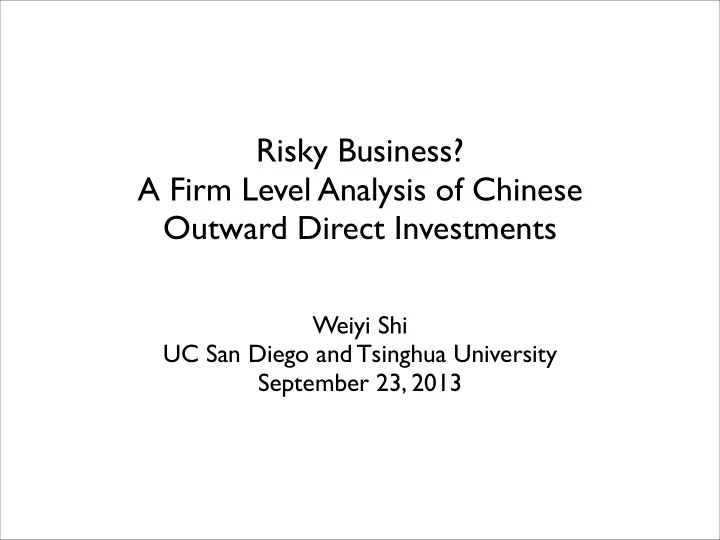

Risky Business? A Firm Level Analysis of Chinese Outward Direct Investments Weiyi Shi UC San Diego and Tsinghua University September 23, 2013
Are Chinese Investors Drawn to Risks? • Preliminary evidence suggests that Chinese companies tend to invest in riskier destinations (Li and Liang 2012, Buckley et al 2007).
Factors Contributing to Risk Profiles • A focus on natural resources and the latecomer effect • State subsidies and policy support • Bilateral relations and connection with aid • Perceived hostility from western developed countries • Competitive advantage in poorly governed countries, cultural and institutional distance
• Research has been hampered by a lack of firm- level data • This study uses two unexplored sources: • MOFCOM’s OFDI registry • 2013 China Outward Direct Investment Survey
Chinese Investments Are Diverse Investment Projects by Industry: 1995-2011 4000 Go Out Strategy Financial Crisis 3000 2000 1000 0 1995 2000 2005 2010 Year Agriculture Extractive Manufacturing Construction Transport and Logistics Trade Exploration Services Source: MOFCOM Registry.
Investment Destinations By Country By Region East$and$Southeast$Asia$ USA$ 4%$ 3%$ 3%$ Northern$America$ 14%$ EU$ EU$ 6%$ Russia$ 30%$ Viet$Nam$ Sub=Saharan$Africa$ 11%$ 7%$ Japan$ 44%$ Middle$East$and$Northern$Africa$ UAE$ Other$European$Countries$ Australia$ 9%$ 6%$ LaEn$America$and$the$Caribbean$ Korea$ 5%$ Singapore$ Oceania$ 11%$ 4%$ Laos$ 16%$ Central$and$Western$Asia$ 4%$ Other$countries$ 3%$ 3%$ 11%$ 3%$ 3%$ Southern$Asia$ Source: MOFCOM Registry, excluding Hong Kong.
• Chinese investments are diverse. • North America and the EU are increasingly top destinations for Chinese investors (but EU may surpass North America according to 2013 COFDIS). • The overall risk profile of Chinese investors could be lower than previously thought.
SOE and Private Investments Look Quite Different Central SOEs Other Companies All As % of total by As % of total by Primary Industry/Activity # projects central SOEs # projects other companies # projects As % of total Agriculture, Fishery, and Forestry 155 9.4% 1,043 5.4% 1,198 5.7% Oil, Gas, and Mineral Extraction 166 10.0% 1,291 6.7% 1,457 6.9% Manufacturing 64 3.9% 2,602 13.4% 2,666 12.7% Utilities 20 1.2% 36 0.2% 56 0.3% Construction 242 14.6% 647 3.3% 889 4.2% Transportation and Logistics 81 4.9% 506 2.6% 587 2.8% Telecom and Information Technology 22 1.3% 346 1.8% 368 1.7% Trade 298 18.0% 7,541 38.9% 7,839 37.2% Hospitality 2 0.1% 97 0.5% 99 0.5% Finance 4 0.2% 11 0.1% 15 0.1% Real estate 11 0.7% 250 1.3% 261 1.2% Business services 510 6.8% 4514 7.0% 5,024 7.0% Research and technical services 74 4.5% 456 2.4% 530 2.5% Entertainment and Culture 3 0.2% 47 0.2% 50 0.2% Business Development 398 24.1% 3159 16.2% 3,557 16.9% Exploration 161 9.7% 686 3.5% 847 4.0% Total Number of Projects 1,652 19,402 21,054 Source: MOFCOM Registry.
SOEs are Investing in Riskier Destinations (1) (2) VARIABLES polity2 polity2 Is a Central SOE -1.846*** -2.052*** (0.209) (0.211) In Extractive Sector -1.124*** -1.263*** (0.178) (0.178) In Agriculture -2.119*** -2.153*** (0.263) (0.262) Year fixed effect No Yes Constant 4.768*** 1.500 (0.0640) (4.702) Observations 13,853 13,853 R-squared 0.013 0.024 Standard errors in parentheses *** p<0.01, ** p<0.05, * p<0.1
SOEs are Investing in Riskier Destinations • SOEs are found to invest in riskier destinations even after controlling for sector, suggesting that the focus on natural resources and the latecomer effect are not all there is to their higher risk profiles.
Perception of Risks Source: 2013 COFDIS.
• SOEs do not consider “high-risk” countries any less risky than their private counterparts, so perception of risks or perceived hostility also cannot fully account for their behaviors.
SOEs Are More Motivated By Policies and Bilateral Agreements Importance+to+company's+decision+to+go+abroad+(1+to+10)+ 6" 6.2" 6.4" 6.6" 6.8" 7" 7.2" 7.4" 7.6" 7.8" 8" China's"Go"Out"Policy" Private" SOE" Host"Country"Policy" Bilateral"Agreements" Source: 2013 COFDIS.
SOEs Have Greater State Support 0%# 10%# 20%# 30%# 40%# 50%# 60%# Subsidies#to#fixed#and#opera9ng#costs# Zero#or#low#interest#loans# Free#or#low#cost#insurane# Private# SOE# Preferen9al#access#to#foreign#exchange# Preferen9al#access#to#reCimport#quota# No#support# Source: 2013 COFDIS.
What Have We Learned? • Chinese OFDI is diverse. • Chinese SOEs are going to riskier destinations, but this tendency cannot be fully explained by China’s resource strategy or the latecomer effect. Risk perception and perceived hostility don’t quite explain it, either. • SOEs’ connection with the Chinese state (especially policy support) may explain in large part their greater tendency to invest in risky destinations.
Recommend
More recommend